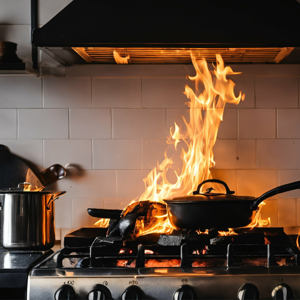
It's all too easy to start a fire while cooking. In fact, the U.S. Fire Administration (USFA) found that during 2017–2021, cooking was the leading cause of reported home fires and home fire injuries and the second leading cause of home fire deaths.. However, not all cooking fires are the same, nor are the damages they cause. A protein fire, for example, happens when you burn meats, eggs or other products that contain protein. The name is somewhat misleading because protein fires don't have to include big flames and lots of dark smoke to cause significant damage. Since there may not be visible soot or smoky residue after a protein fire, you might assume all you need to do is wipe down the area to clean it all up. But once you get a whiff of the smell a protein fire leaves behind, you'll quickly look for a way to rectify it.
Protein Fire Damage Cooking Grease Odor Removal
The smell from a protein fire will permeate your walls and furniture even more than a regular fire would. It can be difficult to pinpoint and remove this odor because protein fire smells quickly absorb into the surrounding upholstery, cabinets, walls and even ceilings. Unlike a regular fire, which leaves behind a layer of soot, a protein fire will leave the items and surfaces in your kitchen and surrounding areas coated in a layer of cooking grease. Removing this slippery, nearly invisible residue is challenging and requires thorough cleaning to fully eliminate the foul odor.
Supplies You Need
- Floor covering
- Ladder
- Bucket
- Warm water
- White Vinegar
- Liquid dishwashing soap (not detergent)
- Sponge/sponge mop
- Soft brush
- Paint (for touchups)
- First, cover your kitchen floor with plastic or old towels to prevent more damage.
- In your bucket, mix 2 tablespoons of vinegar and a squirt of dishwashing soap per quart of warm water.
- Submerge your sponge or sponge mop into the cleaning solution and ring out excess liquid.
- Use the sponge to gently scrub your kitchen countertops, cabinets, walls and ceilings with a back-and-forth motion, repeating steps 2-3 as needed. Use a soft brush for extra scrubbing power on tough grease spots. This process can be time consuming, but you must thoroughly clean all surfaces to remove the lingering smell completely.
- Once you've finished scrubbing, rinse your sponge, pour the remaining solution out and fill your bucket with clean, warm water.
- Gently wipe and remove any residue from the cleaning solution using the fresh water and a clean sponge or rag.
- Remove the cover from your floors and give them a good scrubbing.
- Completely dry all surfaces.
If stains persist, you can cover them with a fresh coat of paint. However, you should not paint until all odors are removed. If odors persist, you may need help from experienced fire damage restoration professionals who can clean the area with advanced tools and processes.
Protein Fire Prevention
To minimize the chance of a protein fire, stay in the kitchen and carefully monitor food and equipment whenever you cook. Keep a fire extinguisher handy in your kitchen at all times. For protection against minor grease splatters, use a stovetop splatter guard to keep grease from sticking to or staining walls and other surfaces. Check the ServiceMaster Restore blog for more fire information, fire cleanup tips, and other ideas that will help keep your home healthy and your family safe. Our expert teams are committed to helping you get from crisis to resolution as soon as possible after a disaster. We are available 24/7/365. Call us today at 1-800-RESPOND to learn more.
